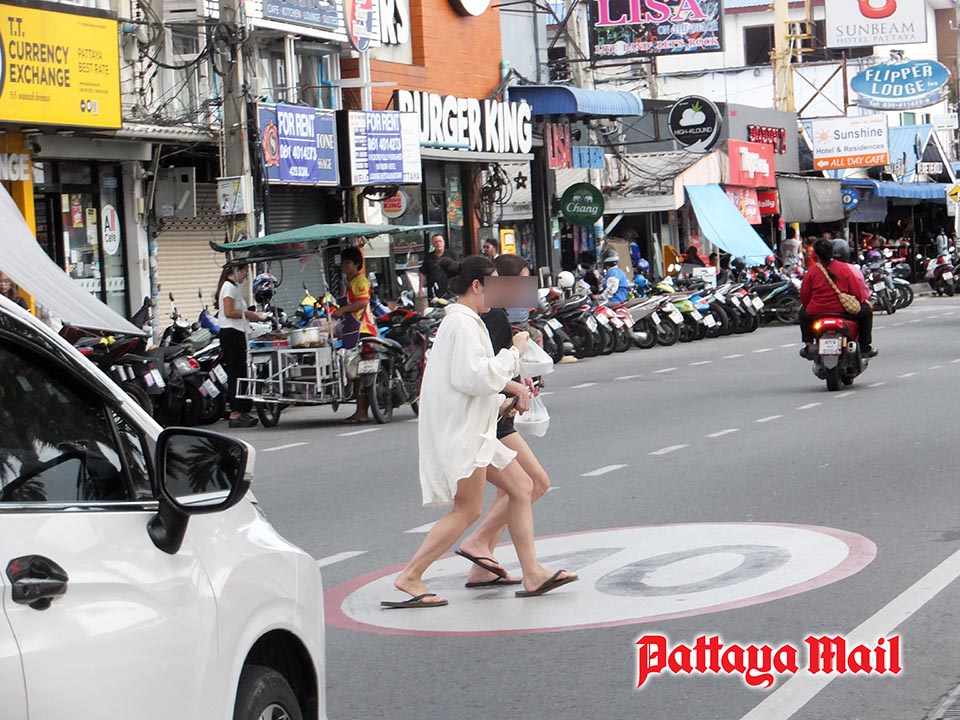Crossing Pattaya’s streets remains hazardous despite red lights, colorful crosswalks, and speed limits
Despite safety measures, pedestrians face challenges crossing Pattaya’s busy streets, as many drivers fail to stop at red lights and crosswalks. (Photo by Jetsada Homklin)
PATTAYA, Thailand — Walking across Pattaya’s streets continues to be a challenge for both locals and tourists, even at well-marked crosswalks with traffic lights and colorful paint. While the city has made visible efforts to improve pedestrian safety, many still find that drivers and motorcyclists often fail to stop — or even slow down — when people are trying to cross.
Residents have expressed frustration, saying that painted crossings and signage are not enough without consistent enforcement. Some noted that even with red lights, vehicles frequently drive through pedestrian zones, leaving people to navigate fast-moving traffic with caution. A common concern among locals is that police presence appears limited. One resident remarked that enforcement is lacking, while others suggested stronger penalties might help — such as fines or license suspensions for those who ignore pedestrian rights.
Major roads like Beach Road and Second Road remain hotspots for risky driving. Many pedestrians report seeing cars and motorcycles speeding well beyond posted limits, even in areas with heavy foot traffic. The concern isn’t just about speed, but about a general disregard for road rules. Residents believe this contributes to near-misses and minor accidents that often go unreported.
Community members have offered several suggestions to help improve the situation. While crosswalks are in place, many argue that physical deterrents would be more effective. Speed bumps before crossings — the kind that slow cars to a crawl in other countries — were mentioned as a practical solution. Others pointed to countries like Australia, where prominent speed bumps near pedestrian zones make it almost impossible to ignore the crossing.
Some suggested using barrier-style crossing arms — similar to those at train crossings — to physically prevent cars from moving while pedestrians are crossing. It’s not just infrastructure that needs attention, residents say, but also education and attitudes. A local pedestrian commented that respect for traffic laws should be reinforced through better training and stronger community awareness.
Reckless driving and inconsistent enforcement continue to undermine pedestrian safety on Pattaya’s main roads, where even painted crosswalks offer little protection. (Photo by Jetsada Homklin)
The discussion also extends to local driving habits. Some feel that standards for obtaining a driver’s license need to be raised. Meanwhile, others noted that tourists aren’t always careful either, sometimes ignoring rules or riding unfamiliar motorbikes in ways that increase risks for everyone on the road.
Traffic signage and one-way systems have also been tried, but their effectiveness is questioned. A few community members said that without strong enforcement, even well-intentioned traffic changes won’t make a lasting difference.
Calls for greater police visibility are widespread. Many believe that if officers were stationed near crosswalks more often — especially at busy intersections — driver behavior might improve. However, some remain unsure whether enforcement will be consistent. One commenter noted that in some Western countries, traffic laws are strictly upheld by officers, while in Pattaya, visible action is less common outside of accidents or occasional checkpoints.
Despite skepticism, residents generally support crosswalk safety campaigns and agree that encouraging respect for pedestrian zones is the right direction. Still, there’s a shared sense that more practical steps — both infrastructural and cultural — are needed to make streets safer.
Until then, crossing Pattaya’s streets remains a cautious endeavor. For many, it’s about watching carefully, waiting patiently, and hoping the next vehicle will actually stop.



